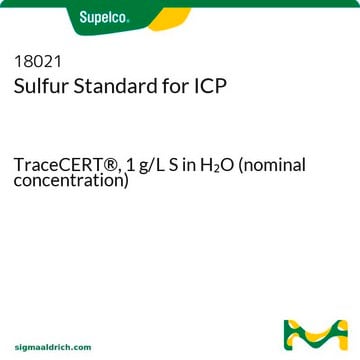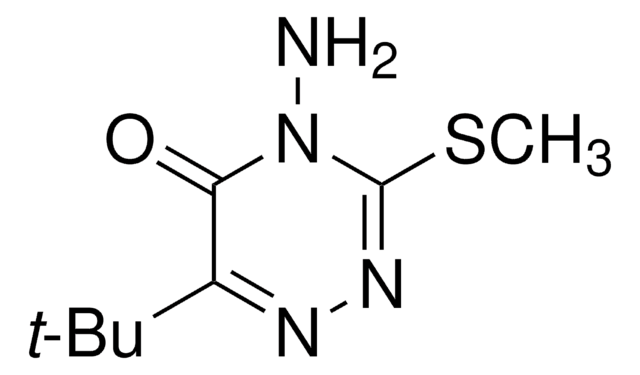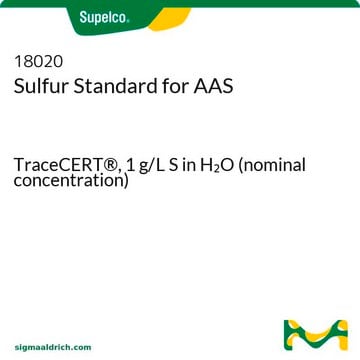Kluczowe dokumenty
36576
Sulfur
PESTANAL®, analytical standard
Wybierz wielkość
131,00 zł
Wybierz wielkość
About This Item
131,00 zł
Polecane produkty
klasa czystości
analytical standard
Poziom jakości
gęstość pary
8.9 (vs air)
ciśnienie pary
1 mmHg ( 183.8 °C)
10 mmHg ( 246 °C)
linia produktu
PESTANAL®
temp. samozapłonu
450 °F
okres trwałości
limited shelf life, expiry date on the label
rezystywność
2E23 μΩ-cm, 20°C
metody
HPLC: suitable
gas chromatography (GC): suitable
bp
444.7 °C (lit.)
mp
112.8 °C (rhombic) (lit.)
117-120 °C (lit.)
119.0 °C (monoclinic) (lit.)
Zastosowanie
agriculture
environmental
Format
neat
ciąg SMILES
[S]
InChI
1S/S
Klucz InChI
NINIDFKCEFEMDL-UHFFFAOYSA-N
Szukasz podobnych produktów? Odwiedź Przewodnik dotyczący porównywania produktów
Powiązane kategorie
Opis ogólny
Zastosowanie
Informacje prawne
Hasło ostrzegawcze
Warning
Zwroty wskazujące rodzaj zagrożenia
Zwroty wskazujące środki ostrożności
Klasyfikacja zagrożeń
Skin Irrit. 2
Kod klasy składowania
4.1B - Flammable solid hazardous materials
Klasa zagrożenia wodnego (WGK)
WGK 1
Temperatura zapłonu (°F)
Not applicable
Temperatura zapłonu (°C)
Not applicable
Środki ochrony indywidualnej
Eyeshields, Gloves, type P3 (EN 143) respirator cartridges
Wybierz jedną z najnowszych wersji:
Certyfikaty analizy (CoA)
Nie widzisz odpowiedniej wersji?
Jeśli potrzebujesz konkretnej wersji, możesz wyszukać konkretny certyfikat według numeru partii lub serii.
Masz już ten produkt?
Dokumenty związane z niedawno zakupionymi produktami zostały zamieszczone w Bibliotece dokumentów.
Klienci oglądali również te produkty
Active Filters
Nasz zespół naukowców ma doświadczenie we wszystkich obszarach badań, w tym w naukach przyrodniczych, materiałoznawstwie, syntezie chemicznej, chromatografii, analityce i wielu innych dziedzinach.
Skontaktuj się z zespołem ds. pomocy technicznej








![(11bR)-2,6-Bis(diphenylphosphino)-N,N-dimethyldinaphtho[2,1-d:1′,2′-f]-1,3,2-dioxaphosphepin-4-amine](/deepweb/assets/sigmaaldrich/product/structures/260/755/3101c3e8-e884-4803-ba52-a87c7e168847/640/3101c3e8-e884-4803-ba52-a87c7e168847.png)

